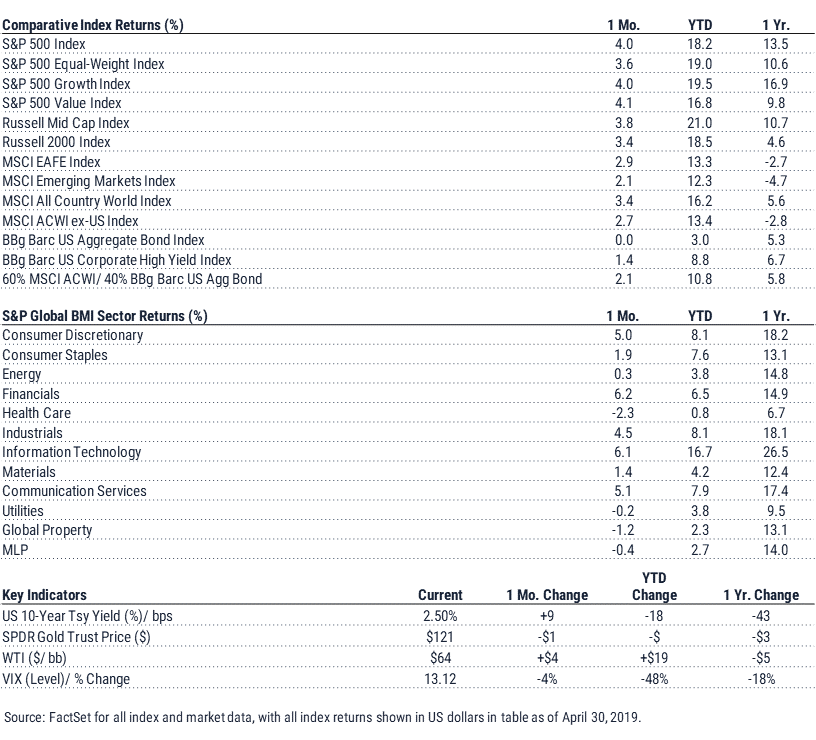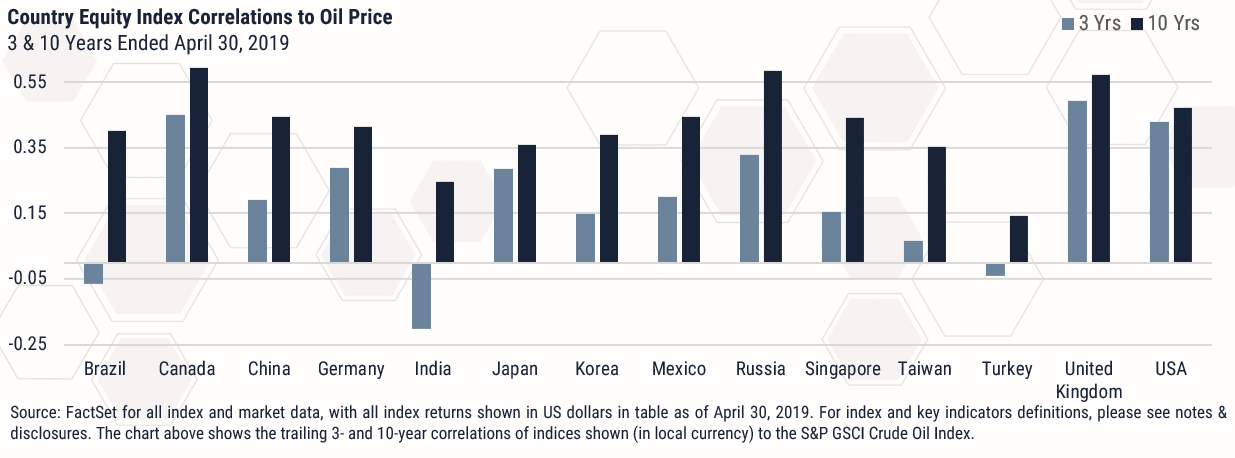April 2019 Global Equity Markets Review
April saw global equity markets carry the exuberant tune from 1Q, with global stocks as measured by the MSCI All Country World Index up 3.4%, led by an S&P 500 up 4.0%. The month proceeded without disruption to key positive themes including increased optimism around economic recovery in China, anticipated resolution of the U.S.-China trade conflict and perhaps most importantly, global central banks tilting highly accommodative.

The US was encouraged further by a strong start to earnings season and March economic data that put into perspective the recession fears that dogged markets in 4Q; namely, a strong March jobs report dissolved lingering concerns about prior-quarter data that captured a weather-related drag and the impacts of a government shutdown in January and February. The Technology and Communication Services sectors drove US markets and thus global markets. While year-to-date the S&P 500 Equal-Weight Index tops the market-weight index (19.0% vs. 18.2%) – articulating the breadth of the rally down the capitalization spectrum – larger names drove incremental strength in US markets in April. The Russell Mid Cap Index (+3.8% for April and 21.0% year-to-date) remains the global leader among major market segments. As measured by the Russell 2000 Index, small caps underperformed in April (+3.4%) and while the index remains above the S&P year-to-date thanks mainly to a market-leading January, it lags very notably trailing one year.
Developed ex-US added 2.7%, as EAFE (+2.9%) and emerging markets (+2.1%) continued to build on robust (albeit lagging) 1Q results. Markets have welcomed the ECB’s plans to defer tightening until at least next year and in the meantime consider measures to support the banking sector and counteract the drag of negative rates. Meanwhile, after several months of worrying activity trends, European economic data surprised to the upside, while the EU granted the UK an extension on Brexit, deferring the immediate possibility of a no-deal departure.
As with the prior quarter, emerging markets’ underperformance may speak more to currency impacts and country-specific hiccups than to the broad macro pressures that have weighed on developed international markets (Europe in particular). While China rose 2.2% to cap a 20% year-to-date gain, India – roughly a tenth of the index – posted less than 1% to the upside and Brazil (at around 8% of the index) shed a percentage point.
Although the current Fed direction spells currency relief for emerging countries, lingering effects of inflation leave the segment exposed to even modest shifts in the other direction - the dollar strengthened slightly during April. Emerging is also a mix of net importers vs. net exporters of oil, so the index saw mixed impacts from the rise in oil price (in April, US termination of sanction waivers on Iran was a major driver). As shown below, however, correlation trends in the nearer-term versus longer-term appear to be weakening among both developed and emerging economies.

Index Returns – all shown in US dollars
All returns shown trailing 4/30/2019 for the period indicated. “YTD” refers to the total return as of prior-year end, while the other returns are annualized. 3-month and annualized returns are shown for:
- The S&P 500 index is comprised of large capitalized companies across many sectors and is generally regarded as representative of US stock market and is provided in this presentation in that regard only.
- The S&P 500® Equal Weight Index (EWI) is the equal-weight version of the widely-used S&P 500. The index includes the same constituents as the capitalization weighted S&P 500, but each company in the S&P 500 EWI is allocated a fixed weight - or 0.2% of the index total at each quarterly rebalance. The S&P 500 equal-weight index (S&P 500 EWI) series imposes equal weights on the index constituents included in the S&P 500 that are classified in the respective GICS® sector.
- The S&P 500 Growth Index is comprised of equities from the S&P 500 that exhibit strong growth characteristics and is weighted by market-capitalization.
- The S&P 500 Value Index is a market-capitalization weighted index comprising of equities from the S&P 500 that exhibit strong value characteristics such as book value to price ratio, cash flow to price ratio, sales to price ratio, and dividend yield.
- The Russell 3000 Index tracks the performance of 3000 U.S. corporations, determined by market-capitalization, and represents 98% of the investable equity market in the United States.
- The Russell Mid Cap Index measures the mid-cap segment performance of the U.S. equity market and is comprised of approximately 800 of the smallest securities based on current index membership and their market capitalization.
- The Russell Micro Cap Index is a market-capitalization weighted index that measures the performance of 2000 small-cap and mid-cap securities. The index was formulated to give investors an unbiased collection of the smallest tradable equities still meeting exchange listing requirements.
- The MSCI All Country World Index provides a measure of performance for the equity market throughout the world and is a free float-adjusted market capitalization weighted index.
- The MSCI EAFE Index is a market-capitalization weighted index and tracks the performance of small to large-cap equities in developed markets of Europe, Australasia, and the Far East.
- The MSCI Emerging Markets Index is a float-adjusted market-capitalization index that measures equity market performance in global emerging markets and cannot be purchased directly by investors.
- The S&P Global BMI sector indices are into sectors as defined by the widely used Global Industry Classification Standards (GICS) classifications. Each sector index comprises those companies included in the S&P Global BMI that are classified as members of respective GICS® sector. The S&P Global BMI Indices were introduced to provide a comprehensive benchmarking system for global equity investors. The S&P Global BMI is comprised of the S&P Emerging BMI and the S&P Developed BMI. It covers approximately 10,000 companies in 46 countries. To be considered for inclusion in the index, all listed stocks within the constituent country must have a float market capitalization of at least $100 million. For a country to be admitted, it must be politically stable and have legal property rights and procedures, among other criteria.
- The Barclay’s US Aggregate Index, a broad based unmanaged bond index that is generally considered to be representative of the performance of the investment grade, US dollar-denominated, fixed-rate taxable bond market.
- The Bloomberg Barclay’s US Corporate High Yield Index, which covers the USD-denominated, non-investment grade, fixed-rate, taxable corporate bond market.
Key Indicators
Key Indicators correspond to various macro-economic and rate-related data points that we consider impactful to equity markets.
- The US 10-Year Treasury Yield (%)/bps, is the return on investment for the U.S. government’s 10-year debt obligation and serves as a signal for investor confidence.
- SPDR Gold Trust Price ($), is an investment fund that reflects the performance on the price of a gold bullion, less the Trust’s expenses.
- West Texas Intermediate, which is an oil benchmark and the underlying asset in the New York Mercantile Exchange’s oil futures contract.
- CBOE Volatility Index (Level)/% Change, which uses price options on the S&P 500 to estimate the market's expectation of 30-day volatility.
This document is intended for informational purposes only and should not be otherwise disseminated to other third parties. Past performance or results should not be taken as an indication or guarantee of future performance or results, and no representation or warranty, express or implied is made regarding future performance or results. This document does not constitute an offer to sell, or a solicitation of an offer to purchase, any security, future or other financial instrument or product. This material is proprietary and being provided on a confidential basis, and may not be reproduced, transferred or distributed in any form without prior written permission from WST. WST reserves the right at any time and without notice to change, amend, or cease publication of the information. This material has been prepared solely for informative purposes. The information contained herein includes information that has been obtained from third party sources and has not been independently verified. It is made available on an "as is" basis without warranty and does not represent the performance of any specific investment strategy.
We consider an index to be a portfolio of securities whose composition and proportions are derived from a rules-based model. See the appropriate disclosures regarding models, indices and the related performance. You cannot invest directly in an index and the performance of an index does not represent the performance of any specific investment. Some of the information enclosed may represent opinions of WST and are subject to change from time to time and do not constitute a recommendation to purchase and sale any security nor to engage in any particular investment strategy.
Past performance or results should not be taken as an indication or guarantee of future performance or results, and no representation or warranty, express or implied is made regarding future performance or results.
Besides attributed information, this material is proprietary and may not be reproduced, transferred or distributed in any form without prior written permission from WST. WST reserves the right at any time and without notice to change, amend, or cease publication of the information. This material has been prepared solely for informative purposes. The information contained herein may include information that has been obtained from third party sources and has not been independently verified. It is made available on an “as is” basis without warranty. This document is intended for clients for informational purposes only and should not be otherwise disseminated to other third parties. Past performance or results should not be taken as an indication or guarantee of future performance or results, and no representation or warranty, express or implied is made regarding future performance or results. This document does not constitute an offer to sell, or a solicitation of an offer to purchase, any security, future or other financial instrument or product.
